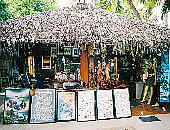|
The Maldives

Economy
The
Maldivian economy is based on
tourism and fishing. The population
of capital island ,maleí more when
compared to other islands.
Development has been centered upon
the tourism industry and its
complementary service sectors,
transport, distribution, real
estate, construction, and
government.
Due to tsunami on December 26,
2004,the damage of Maldives
estimated at $450 million
(approximately 60% of GDP). Maldivesí
economy fell down by about 5% in
2005, as the result of decreased
tourist inflows.
Since 1997, the Maldives has been
running a merchandise trade deficit
in the range of $200 to $260 million
annually. But in 2004 the trade
deficit ballooned to $386 million
as a result of increased oil price.
A 1956 bilateral agreement gave the
United Kingdom the use of Gan for 20
years as an air facility in return
for British aid.The British closed
theGan air station as soon as the
agreement ended in 1976.
Economic
Sectors
Tourism:
The main source of income of
Maldives is tourism (beautiful,
unpolluted beaches on small coral
islands, diving in blue waters
abundant with tropical fish, and
glorious sunsets). Tourism now
brings in about $210 million a year.
Tourism and related services
contributed 33% of GDP in 2004. The
number of tourists (mainly from
Europe) visiting the Maldives
increased from 1,100 in 1972 to
617,000 in 2004.
Fishing: This sector employs about
11% of the labor force and
contributes 6% of GDP, including
fish preparation. The use of nets is
illegal, so all fishing is done by
line. Production was about 158,000
metric tons in 2004, most of them
are skipjack tuna. About 50% is
exported, largely to Sri Lanka,
Japan, Hong Kong, Thailand, and the
European Union. Total export
proceeds from fish were about $85
million in 2004. The fishing fleet
consists of some 1,647 small,
flat-bottomed boats (dhonis).
Agriculture: Since Poor soil and
scarce arable land, only a few
subsistence crops can be cultivated,
such as coconut, banana, breadfruit,
papayas, mangoes, taro, betel,
chilies, sweet potatoes, and onions.
Almost all food, including staples,
has to be imported. Agriculture
provides about 2.5% of GDP.
Industry and manufacturing: The
industrial sector provides only
about 8% of GDP. Traditional
industry consists of boat building
and handicrafts. Modern industry is
limited to a few tuna canneries, a
bottling plant, and a few
enterprises in the capital producing
PVC pipe, soap, furniture, and food
products. Five garment factories
that had exported principally to the
United States closed in 2005.
Economy Overview
Tourism, Maldives' largest industry,
accounts for 28% of GDP and more
than 60% of the Maldives' foreign
exchange receipts. Over 90% of
government tax revenue comes from
import duties and tourism-related
taxes. Fishing is the second leading
sector. Agriculture and
manufacturing continue to play a
lesser role in the economy,
constrained by the limited
availability of cultivable land and
the shortage of domestic labor. Most
staple foods must be imported.
Industry, which consists mainly of
garment production, boat building,
and handicrafts, accounts for about
7% of GDP.
The Maldivian Government began an
economic reform program in 1989
initially by lifting import quotas
and opening some exports to the
private sector. Subsequently, it has
liberalized regulations to allow
more foreign investment. Real GDP
growth averaged over 7.5% per year
for more than a decade. In late
December 2004, a major tsunami left
more than 100 dead, 12,000
displaced, and property damage
exceeding $300 million. As a result
of the tsunami, the GDP contracted
by about 3.6% in 2005.
A rebound in tourism, post-tsunami
reconstruction, and development of
new resorts helped boost GDP by
about 18 percent in 2006. The trade
deficit has expanded sharply as a
result of high oil prices and
imports of construction material.
Diversifying beyond tourism and
fishing is the major challenge
facing the government. Over the
longer term Maldivian authorities
worry about the impact of erosion
and possible global warming on their
low-lying country; 80% of the area
is one meter or less above sea
level.
|